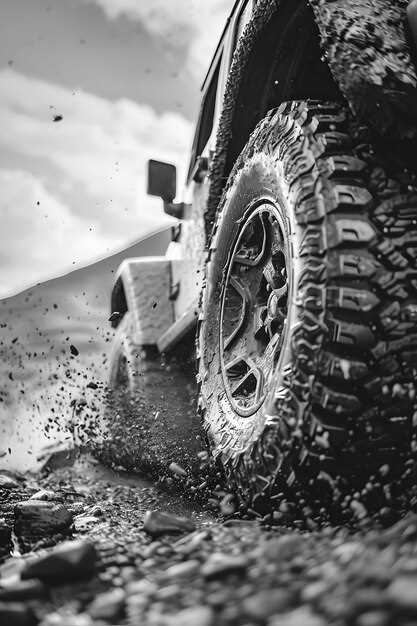
The Toyota 4Runner has long been recognized as a formidable player in the realm of off-road vehicles, with a legacy that spans several decades. This iconic SUV combines rugged durability, advanced technology, and a proven four-wheel-drive system, making it a favorite among outdoor enthusiasts and adventure seekers alike. In this analysis, we will delve into the specific off-road capabilities of the Toyota 4Runner, exploring its features, performance metrics, and overall adaptability to various terrains.
At the heart of the 4Runner’s off-road prowess lies its robust construction and advanced engineering. Built on a body-on-frame platform, the 4Runner is designed to withstand the rigors of challenging environments, from rocky trails to muddy backroads. The vehicle is equipped with a potent V6 engine that provides ample power for navigating steep inclines and rugged landscapes. Moreover, features such as Multi-Terrain Select and Crawl Control ensure that drivers can confidently tackle obstacles, regardless of the conditions they encounter.
In addition to its impressive mechanical attributes, the Toyota 4Runner boasts a comprehensive suite of off-road technologies. The vehicle’s Active Traction Control and Hill Start Assist enhance stability and control, allowing drivers to navigate tricky situations with ease. Together, these elements contribute to the 4Runner’s reputation as a reliable off-road partner, capable of handling everything from sandy dunes to snow-covered paths. In this article, we will provide a detailed examination of these capabilities and highlight why the Toyota 4Runner remains a top choice for off-road enthusiasts.
Tire Options and Performance Impact on Off-Roading
The choice of tires plays a crucial role in enhancing the off-road capabilities of the Toyota 4Runner. Off-road tires are specifically designed to provide better traction, durability, and stability on uneven terrains, which is essential for tackling various obstacles such as mud, rocks, and sand.
All-terrain tires offer a versatile option, combining on-road comfort with off-road performance. They feature a tread design that balances traction and noise levels, making them suitable for daily driving while still capable of handling moderate off-road conditions. However, for more extreme off-road adventures, mud-terrain tires are recommended. These tires have deeper grooves and more aggressive patterns that excel in muddy and loose surfaces, providing superior grip where standard tires might struggle.
Additionally, tire size can significantly impact the 4Runner’s off-road performance. Larger tires increase ground clearance, which is beneficial for navigating rough landscapes. However, there is a trade-off, as oversized tires may affect the vehicle’s handling and fuel efficiency. Proper wheel alignment and gearing adjustments are often necessary to accommodate larger tires without compromising the vehicle’s overall functionality.
Another important factor is tire pressure. Lowering tire pressure increases the tire’s footprint, enhancing traction and allowing for better performance on soft surfaces like sand or snow. However, it’s essential to strike a balance, as too low of a pressure can lead to tire damage or loss of control.
Proper tire maintenance is equally vital for optimal off-road performance. Regular inspections for wear, damage, and proper inflation help ensure that the tires perform as intended in rugged conditions. Additionally, rotating tires regularly can enhance their lifespan and maintain consistent handling characteristics.
In summary, selecting the right tire type, size, and maintenance regimen significantly influences the Toyota 4Runner’s off-road performance. With careful consideration of these factors, drivers can maximize their vehicle’s capabilities, ensuring a thrilling and successful off-road experience.
Comparison of Traction Control Systems in Various Terrain Conditions

The ability of an off-road vehicle to navigate diverse terrains is heavily influenced by its traction control system (TCS). In various conditions such as mud, sand, gravel, and rock, the TCS plays a critical role in maintaining optimal grip and stability.
In muddy terrain, the TCS must effectively prevent wheel spin. It achieves this by selectively applying brake pressure to spinning wheels, allowing power to be transferred to wheels with better traction. Vehicles equipped with advanced TCS can adjust to the shifting consistency of mud, enhancing performance by redistributing torque.
On sandy surfaces, traditional traction control systems may struggle due to the inherent lack of traction. However, modern off-road vehicles often include a sand mode in their TCS settings, which modify throttle response and reduce braking interventions. This allows the vehicle to maintain momentum and float over the sand, rather than getting bogged down.
In rocky environments, the traction control system’s ability to provide incremental power to each wheel is crucial. Many off-road essential systems, such as rear-locking differentials, work in conjunction with TCS to ensure that torque is maximized on wheels that maintain contact with the ground. This synergy enables the vehicle to scale steep inclines and navigate uneven surfaces more effectively.
Gravel roads can present unique challenges, as the loose surface can cause vehicles to slide or lose control. Here, the TCS helps maintain stability by managing wheel slip while allowing a degree of mobility. By adjusting the braking force and power distribution between the wheels, the system aids in keeping the vehicle on its intended path.
Overall, the effectiveness of traction control systems in off-road conditions relies on their adaptability to terrain changes. The integration of different driving modes and response mechanisms allows modern vehicles, like the Toyota 4Runner, to excel in diverse environments, ensuring safety and enhancing performance on challenging off-road adventures.
Real-World Off-Roading Experiences: User Insights and Modifications

The Toyota 4Runner has gained a loyal following among off-road enthusiasts. Users frequently share their experiences, emphasizing the vehicle’s robust design and adaptability for rugged terrains. Below are key insights gathered from various user experiences:
- Traction and Stability: Many users praise the 4Runner’s stability on uneven surfaces. The hill-start assist and dynamic traction control features enhance off-road performance, making steep climbs and descents manageable.
- Ground Clearance: The 4Runner’s impressive ground clearance allows for better navigation over obstacles such as rocks and logs. Owners frequently mention this feature as a significant advantage during trail runs.
- Suspension Upgrades: A common modification among 4Runner owners is upgrading the suspension system. Many choose to install aftermarket lift kits to improve off-road handling and increase articulation for more challenging terrains.
- Tires for Off-Road Performance: Users often switch to all-terrain or mud-terrain tires to enhance grip and performance. This simple modification allows for better traction in various conditions, including mud, sand, and snow.
- Skid Plates: Adding skid plates is a popular modification to protect the undercarriage from rocks and debris. Many owners have reported that these plates provide peace of mind when tackling rugged trails.
- Auxiliary Lighting: Off-roading at night can be challenging without adequate lighting. Owners frequently add LED light bars or spotlights to improve visibility during nocturnal adventures.
- Recovery Gear: Users stress the importance of having proper recovery equipment, such as winches, tow straps, and traction boards. These tools prove invaluable in challenging scenarios where the 4Runner may become stuck.
- Community and Resources: Many 4Runner owners engage with online communities, sharing their modifications and experiences. These platforms provide invaluable advice on enhancing off-road capabilities, from technical tips to recommended gear.
In summary, real-world experiences from Toyota 4Runner users highlight the vehicle’s inherent off-road strengths while showcasing modifications that further enhance its capabilities. Through careful upgrades and community engagement, owners maximize their off-roading adventures, demonstrating the 4Runner’s potential in diverse environments.




